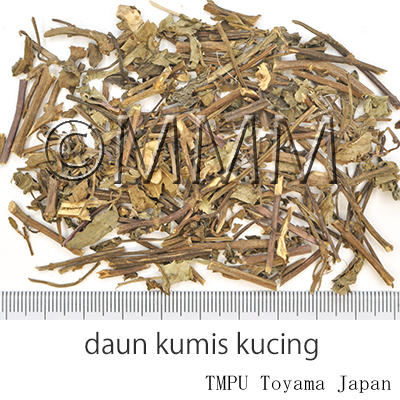Crude drug sample data base
※Click on the image to enlarge it.
The capital city, provincial capital city or the representative
location of its administrative area is indicated.
location of its administrative area is indicated.
-6.17511
106.86503949999997
Production area information
Republic of Indonesia,Jakarta Special Capital Region
https://ethmed.toyama-wakan.net/img/pin_san.png
-6.17511
106.86503949999997
Collection information
Republic of Indonesia,Jakarta Special Capital Region
https://ethmed.toyama-wakan.net/img/pin_nyu.png
Scientific information data base
| Crude drug name | Indonesian name, English name | Daun remujung, Java tea | ||||
|---|---|---|---|---|---|---|
| crude drug image |
| |||||
| Original plant name | Orthosiphon grandiflorus (Blume) Bold. | |||||
| Family name | Labiatae | |||||
| Used part | Leaves | |||||
| Distribution area | It grows wild throughout Indonesia on the riverbanks, in thickets, grasslands, along roadsides and forest borders. In Java (Indonesia) it occurs up to 700m altitude [201]. It is also planted in gardens as ornamental [205]. | |||||
| Description | Leaves decussately opposite, ovate or rhombic, cuneate at base, acute or acuminate at apex, serrate, glabrous or minutely pubescent, 7-10 cm x 8-50 cm. The plant is a perennial herb, 25-200 cm tall; stem ascending and quadrangular. Inflorescence an opposed cyme arranged in terminal racemes, 7-29 cm long. Flowers pedicellate; stamen 4, long protruding from the corolla tube. Fruit splitting into 4 oblong-ovoid nutlets, brownish, rugose [205, 207]. | |||||
| Drug effect | Bitter, cooling. It is used as anti-inflammatory and diuretic [231]. | |||||
| Specific actions | Diuretic.. | |||||
| Frequency in use | Abundant. | |||||
| Pharmacological effect | Orthosiphonis Folium (the dried leaves and stem tips of O. grandiflorus) has antimicrobial properties [205]. The lipophilic flavonoids have shown inhibitory effect against Ehrlich ascites tumour cells in vitro [205]. | |||||
| Medical system | Indonesian medicine (Jamu) | |||||
| Traditional usage | It is commonly used as a diuretic in teas and infusions in treating various kidney complaints , including renal calculi. It is used in combination with other herbs, such as with Phyllanthus niruri to enhance its therapeutic effectiveness against kidney illnesses. It is also used in combination with turmeric and leaves of Graptophyllum pictum for renal calculi [201]. Its diuretic property is related to the high potassium content of the leaves. It is used to treat diabetes in combination with the leaves of Andrographis paniculata, and to treat jaundice in a mixture with leaves of Blumea balsamifera, leaves of Phyllanthus fraternus and rhizome of Curcuma xanthorrhiza. [205]. In mixtures with leaves of other plants it is also used against gout rheumatism and arteriosclerosis. | |||||
| Formulation | 1) Diuretic (especially when a phosphate in urine): 3 grams of fresh leaves are boiled with 1000 ml of water until water is reduced to 750 ml. Strain, drink 1/2 cup of the tea 4 times a day [201]. 2) Renal calculi: 6 grams of aboveground parts of O. grandiflorus and 7 aboveground parts of Phyllanthus niruri are boiled with 110 ml of water. Stand to cool and strain. Drink 100 ml of the infusion twice a day for 14 days [231]. Note: existing kidney stones have to be expelled by taking Sericocalyx crispus before taking the above formula [231]. 3) Diabetes: 20 pieces of fresh leaves, 20 pieces of leaves of Andrographis paniculata are boiled with 110 ml of water. Drink the decoction 100 ml once a day [231]. | |||||
| References | Reference book Tips! | [201] K. Heyne, Tumbuhan Berguna Indonesia, Vols. 1-4, 1987. Diedarkan Oleh Koperasi Karyawan Departemen Kehutanan, Jakarta, Indonesia. Vol. 3, p 1705. [205] de Pdua, L.S., Bunyapraphatsara, N. and Lemmens, R.H.M.J. (Editors), 1990. Plant Resources of South-East Asia No. 12 (1). Medicinal and poisonous plants 1. Backhuys Publishers, Leiden, Netherlands. p 368. [207] Badan Penelitian Dan Pengembangan Kesehatan and Departemen Kesehatan, Kesejahteraan Sosial Ri. Vols. 1-5, Inventaris Tanaman Obat Indonesia, Jakarta, Indonesia. Vol. 1, Part 1 (2000), pp 173-174. [231] Soedibyo, Mooryati: Alam Sumber Kesehatan: Manfaat dan Kegunaan (Natural resources for health. Benefits and uses). Balai Pustaka. 1998. pp 228-229. | ||||
| Remarks | Leaves are sold in capsules on the market in Indonesia, either pure or in combination with other ingredients [205]. | |||||
| Last renewal date | 2024/03/04 | |||||






